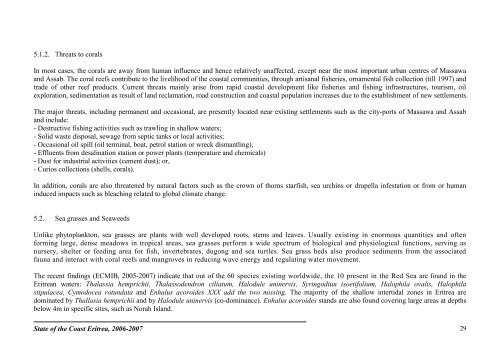Eritrea's Coastal Marine and Island Biodiversity Conservation Project
Eritrea's Coastal Marine and Island Biodiversity Conservation Project
Eritrea's Coastal Marine and Island Biodiversity Conservation Project
You also want an ePaper? Increase the reach of your titles
YUMPU automatically turns print PDFs into web optimized ePapers that Google loves.
5.1.2. Threats to corals<br />
In most cases, the corals are away from human influence <strong>and</strong> hence relatively unaffected, except near the most important urban centres of Massawa<br />
<strong>and</strong> Assab. The coral reefs contribute to the livelihood of the coastal communities, through artisanal fisheries, ornamental fish collection (till 1997) <strong>and</strong><br />
trade of other reef products. Current threats mainly arise from rapid coastal development like fisheries <strong>and</strong> fishing infrastructures, tourism, oil<br />
exploration, sedimentation as result of l<strong>and</strong> reclamation, road construction <strong>and</strong> coastal population increases due to the establishment of new settlements.<br />
The major threats, including permanent <strong>and</strong> occasional, are presently located near existing settlements such as the city-ports of Massawa <strong>and</strong> Assab<br />
<strong>and</strong> include:<br />
- Destructive fishing activities such as trawling in shallow waters;<br />
- Solid waste disposal, sewage from septic tanks or local activities;<br />
- Occasional oil spill (oil terminal, boat, petrol station or wreck dismantling),<br />
- Effluents from desalination station or power plants (temperature <strong>and</strong> chemicals)<br />
- Dust for industrial activities (cement dust); or,<br />
- Curios collections (shells, corals).<br />
In addition, corals are also threatened by natural factors such as the crown of thorns starfish, sea urchins or drupella infestation or from or human<br />
induced impacts such as bleaching related to global climate change.<br />
5.2. Sea grasses <strong>and</strong> Seaweeds<br />
Unlike phytoplankton, sea grasses are plants with well developed roots, stems <strong>and</strong> leaves. Usually existing in enormous quantities <strong>and</strong> often<br />
forming large, dense meadows in tropical areas, sea grasses perform a wide spectrum of biological <strong>and</strong> physiological functions, serving as<br />
nursery, shelter or feeding area for fish, invertebrates, dugong <strong>and</strong> sea turtles. Sea grass beds also produce sediments from the associated<br />
fauna <strong>and</strong> interact with coral reefs <strong>and</strong> mangroves in reducing wave energy <strong>and</strong> regulating water movement.<br />
The recent findings (ECMIB, 2005-2007) indicate that out of the 60 species existing worldwide, the 10 present in the Red Sea are found in the<br />
Eritrean waters: Thalassia hemprichii, Thalassodendron ciliatum, Halodule uninervis, Syringodiun isoetifolium, Halophila ovalis, Halophila<br />
stipulacea, Cymodocea rotundata <strong>and</strong> Enhalus acoroides XXX add the two missing. The majority of the shallow intertidal zones in Eritrea are<br />
dominated by Thallasia hemprichii <strong>and</strong> by Halodule uninervis (co-dominance). Enhalus acoroides st<strong>and</strong>s are also found covering large areas at depths<br />
below 4m in specific sites, such as Norah Isl<strong>and</strong>.<br />
State of the Coast Eritrea, 2006-2007 29


